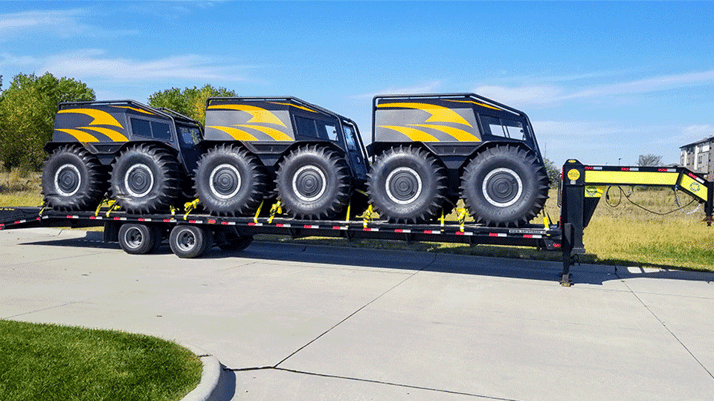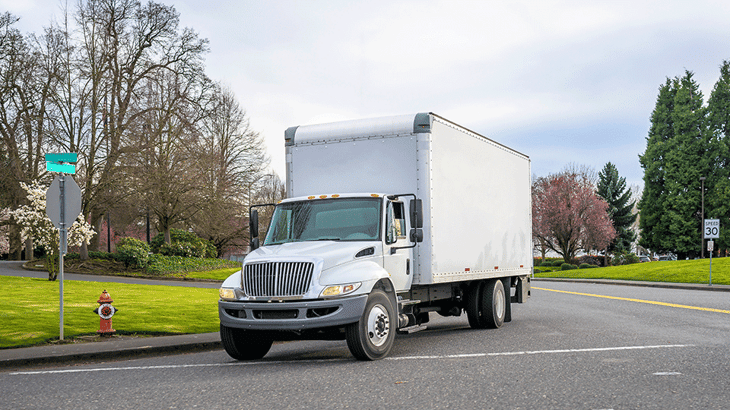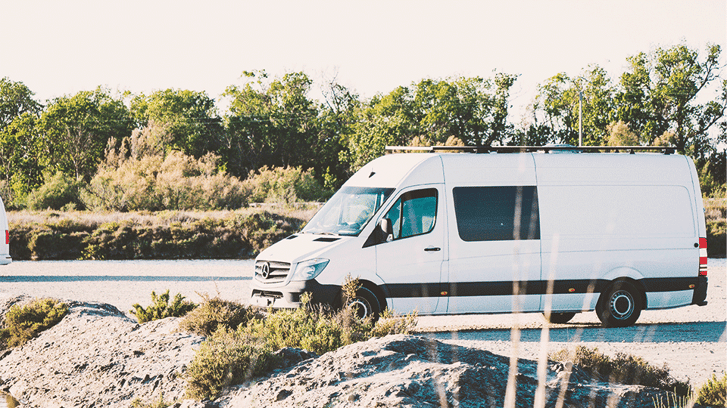When it comes to transportation and logistics, trillions of dollars worth of cargo moves across the U.S. every year via semi-truck (or a motorized alternative), accounting for over 70 percent of all U.S. freight movement.
Transportation companies (freight brokers, asset carriers, 3PLs, etc.) have many tactics and solutions for shouldering this burden, covering the specific needs of the U.S.’ many different companies and manufacturers.
Sometimes, these solutions are interchangeable — as is the case with less “complex” freight moves; smaller shipments, palletized retail goods, etc. Other situations warrant a more specific, specialized approach (like heavy haul trucking and over-dimensional shipping).
If your company’s freight falls into the former category — neither over-dimensional, complex or in need of heavy haul service(s) — two things are likely:
- There are multiple methods for getting this cargo from A to B.
- Your level of cost control in this situation will rise (to match these additional choices).
Here at Anderson Trucking Service (ATS), we have been helping companies, like yours, move their freight since 1955. Throughout the years, this has taken many forms, and today we offer a wide range of transportation solutions using our asset fleet and brokerage authority.
Providing every service at a high level — from full-truckload open-deck and van to partial, less-than-truckload and even hot shot services — is difficult. That said, our experience and capabilities give us a unique understanding of each of them.
In this article, let’s talk about the main solutions for moving “small” freight shipments. There are plenty of options for transporting these loads. Many of them (probably) apply to your situation.
But which transportation services will meet your needs? What do they cost? And, most importantly, how can you make sure the solution you choose truly aligns with the goals you’ve set?
The main solutions for shipping “small” quantities of freight — freight that doesn’t require full-truckload coverage — are:
- Hot shot trucking service
- Straight truck shipping service
- Sprinter van shipping service
- Partial truckload (PTL) shipping service
- Less-than-truckload (LTL) shipping service
Let’s go over these services, their cost and the pros and cons of utilizing them.
Hot Shot Trucking Service
Hot shot trucking service has become increasingly popular over the last decade.
Performed by an individual operating a medium-duty pickup truck and pulling a hot shot trailer (of which there are many kinds), “hot shotting” freight can be convenient and cost-effective.
Hot Shot Trailer Dimensions
Hot shot trailers come in several variations and sizes. Commonly, hot shots are 30-40 feet long and 8 feet, 6 inches wide with the ability to haul cargo upwards to 10 feet tall. In most cases, the maximum weight a hot shot trailer can load ranges from 12,000-18,000 pounds.
What Kind of Freight Can Be Shipped on a Hot Shot?
Hot shot trailers offer similar capabilities to their 48-/53-foot open-deck counterparts.
Among the long list of cargoes that hot-shot trucking is a viable solution for are:
- Palletized materials/products
- Lumber
- Small machinery
- Bricks
- Plastics
- Steel Products
- Wire, ropes, cables
- Small generators
Note: Many hot shot trailers feature ramps, making this a great solution for moving self-propelled machinery and equipment.

Advantages of Hot Shot Trucking
In the right situation, hot shot trucking can be singularly advantageous. That said, compared to the other options on this list, here are the main advantages of hot shot trucking:
- Hot shot trucking is always cheaper than full-truckload shipping.
- Hot shot trucking is a “dedicated” service, allowing for a more expeditious transit than PTL and LTL services.
- Because hot-shot service is “dedicated,” shippers are allowed greater tracking capabilities than partial-truckload and less-than-truckload services can provide.
Disadvantages of Hot Shot Trucking
Here are some reasons you might not want to use hot shot service for your next load:
- Hot shot trailers can only haul up to 18,000 pounds.
- Hot shot trucking is more expensive than partial-truckload and less-than-truckload services.
- Many hot shot trailers don’t have air-ride suspension. This can increase instances of cargo damage on rough roadways and long(er) hauls.
Hot Shot Trucking Cost
Like other dedicated services, hot-shot trucking rates are based on a ton of factors including:
- Your level of urgency (as this increases, expect your rate to rise)
- Load-to-truck ratios in your origin (the number of other shippers in your area that need a solution compared to the number of solutions)
- Load-to-truck ratios in your destination (the number of outbound loads and transportation solutions in your destination)
- Tarping and other accessorials
- Your length of haul (the fuel used, the amount of time the driver spends moving your freight, etc.)
In the end, hot shot trucking rates can vary substantially from one situation to another. That said, the overall cost of this service will be lower than securing a full-truckload solution.
Related Content: What is Hot Shot Trucking?
Straight Truck Shipping Service
Straight trucks (which are also sometimes called “cube” or “box” trucks) are single-frame motor vehicles. In recent history, these trucks have become an increasingly common way to transport freight as they present a dedicated, enclosed solution for shippers to depend on.
Straight Truck Dimensions
Straight trucks are essentially smaller dry vans and are manufactured in a variety of lengths. Most commonly, straight trucks are 22-26 feet long and can carry a maximum of 8,000-10,000 pounds of cargo weight. Internally, these trucks usually measure 96 inches wide by 96 inches tall (your situation may vary).

What Kind of Freight Can Be Shipped on a Straight Truck?
Because they are enclosed trailers and commonly feature a liftgate, straight trucks are used in place of 53-foot dry vans. As such, should it make sense for your business, plan to use straight trucks for dry van commodities like:
- Palletized and boxed freight
- General merchandise/retail goods
- Food products
- Manufacturing parts/materials
- Some hazmat goods
- Temperature-controlled products (with refrigeration unit)
- Fixtures and equipment
Advantages of Straight Truck Shipping
If you’re looking for an expeditious, dedicated transportation solution, straight truck services fit this mold. The main advantages of sending your cargo in a straight truck are:
- Straight truck shipping is always cheaper than full-truckload shipping.
- Straight truck shipping can be more expeditious than LTL and PTL services.
- Load tracking capabilities are more robust and accurate for dedicated services, like straight truck shipping, compared to non-dedicated solutions like LTL and PTL.
- Fewer handling points reduce the likelihood that cargo damage occurs.
Disadvantages of Straight Truck Shipping
Compared to these other services, here are the disadvantages of using a straight truck:
- Securing a straight truck will be more difficult than locking down PTL, LTL or FTL service.
- Straight trucks can only load up to 10,000 pounds, limiting their use cases.
- Straight truck shipping is more expensive than PTL and LTL services.
Straight Truck Shipping Service Cost
Once again, the price you pay to use a straight truck is determined by several factors. These factors include but aren’t limited to:
- Load-to-truck ratios (the number of straight trucks in your area weighed against the demand for their capacity).
- The urgency of your shipment (as your urgency rises, so will your price).
- The distance your freight needs to travel (the fuel used on your shipment and that driver's time spent hauling it).
- Current weather conditions along your freight’s route (bad weather limits your pool of willing solutions, increasing your price).
Like most other services, straight truck shipping prices will vary based on your situation. To ensure you receive an accurate quote, work with a transportation provider that has experience pricing these loads.
Related Content: What Are Straight/Box Trucks and How Are They Used to Ship Freight?
Sprinter Van Shipping Service
Commonly used as an alternative to LTL service, sending your cargo in a sprinter van is a unique way to ensure expedited delivery. These vans don’t exceed the gross vehicle weight thresholds that would classify them as “commercial motor vehicles.” As a result, sprinter van operators aren’t required to follow the Federal Motor Carrier Safety Administration’s (FMCSA’s) hours of service regulations. This allows them to travel from A to B with far fewer restrictions. For this reason, and a handful of others, sprinter van service is an effective way to move cargo — particularly on a tight schedule.
Sprinter Van Dimensions
Depending on their make and model, sprinter vans vary in size. That said, typically their cargo capacity maxes out around 4 feet wide, 8 feet high and 8-15 feet long. Due to this limited space, sprinter vans can haul a maximum of four pallets. Don’t expect to get more than 5,000 pounds of cargo into a sprinter van.

What Kind of Freight Can Be Shipped in a Sprinter Van?
Any shipment that fits within its dimensional confines can be hauled by a sprinter van. More specifically, sprinter vans are used to move:
- Palletized materials/products
- Manufacturing materials
- Raw materials
- Finished products
Sprinter vans can not be used to haul hazardous materials or temperature-controlled goods.
Advantages of Sprinter Van Shipping
Here are the advantages of using a sprinter van for your next shipment:
- Sprinter vans are one of the most expeditious methods for moving freight.
- Sprinter vans are usually cheaper than booking an entire truck.
- Shipping in a sprinter van provides a dedicated solution, allowing shippers to avoid multiple handling points and in-transit tracking issues.
Disadvantages of Sprinter Van Shipping
Though using a sprinter van is a great solution in some situations — and is commonly used to expedite LTL freight after it leaves a company’s dock — there are also some disadvantages to be aware of:
- Securing a sprinter van will be more expensive than using a straight truck, PTL service, LTL service and hot shot service.
- Sprinter vans have limited cargo space, making them a viable solution in very select situations.
- Sprinter vans aren’t available for every lane. This is especially true on short notice.
Sprinter Van Shipping Service Cost
The cost of securing a sprinter van will vary depending on the distance to your pickup, your freight’s length of haul, how quickly your freight needs to arrive and the demand for sprinter truck service in your area. Together these factors — and several others — dictate the rate you pay to lock down a sprinter van.
Note: sprinter vans aren’t nearly as available as other services on this list. Reduce your rate by giving your provider as much lead time as possible when requesting this service.
Related Content: What is Expedited Freight Shipping?
Partial-Truckload (PTL) Shipping Service
Partial truckload service is a common piece of many supply chains. Carriers offer this service by selling portions of a 53-foot trailer to multiple parties. Once their trailer is booked, a partial-truckload driver proceeds to pick up/drop off freight from/to multiple locations. Usually, PTL services are offered along a certain route, allowing drivers to pre-plan their trailer space and pick-up/drop-off schedule.
PTL Shipping Dimensions
Shippers book PTL service by securing a portion of a 53-foot trailer (dry van or flatbed). Although the quantity you ship is up to you, PTL shipping makes the most sense (financially) when. . .
- Total cargo weight falls between 5,000 and 30,000 pounds
- Total cargo length is between 8 and 30 feet
- Total pallet count (where applicable) is 5-15 pallets
Rule of thumb: Whenever your freight will occupy more than half of a 53-foot trailer, PTL shipping might not be your best option.
What Kind of Freight Can Be Shipped PTL?
Most commodities can be shipped using PTL service. Whether you usually move open-deck cargoes or dry van products/materials, there will be a PTL solution for you.
However, hazmat and temperature-controlled freight are more difficult to ship using PTL service. Since these kinds of shipments don’t mix well with others, you may have trouble finding a viable PTL solution for moving them.
Advantages of PTL Shipping
Compared to the other transportation services on this list, here are the advantages of PTL shipping:
- PTL carriers plan out their pickup and delivery schedules based on the freight they’ve booked. This ensures that once your cargo is loaded it isn’t touched until it arrives — decreasing the likelihood of freight damage.
- PTL is more cost-effective than using multiple sprinter vans, a straight truck and full truckload shipping.
- Compared to LTL shipping, PTL has far fewer accessorials fees.
- PTL is usually quicker than LTL shipping.
Disadvantages of PTL Shipping
Here are the most glaring disadvantages PTL service presents:
- Because these trucks make multiple pickups, getting one to your door can take more time than dedicated services.
- Because these trucks make multiple drops, transit and delivery timing will be longer than dedicated services.
- PTL shipping is usually more expensive than LTL shipping.
PTL Shipping Cost
Typically, the cost of PTL capacity directly correlates to the percentage of overall trailer space a shipper is using. If, for example, your freight is 15 feet long, occupying 28 percent of a 53-foot trailer and the rate of dedicated service (an entire trailer) is $1,000, expect to pay $280 to secure PTL capacity.
This is not an exact calculation and your situation will vary. That said, as the amount of deck space your freight utilizes increases — reducing the space available for other shippers — your price will increase.
Related Content: What is Partial-Truckload (PTL) Freight Shipping? [Pros + Cons]
Less-Than-Truckload (LTL) Shipping Service
Of the services on this list, LTL shipping is the most commonly used. There are transportation companies that specialize in LTL service exclusively, utilizing an asset fleet and terminal network.
Similar to parcel shipping, LTL service moves freight from terminal to terminal and truck to truck, inching it closer to its final destination with each move. Though LTL service isn’t right for time-sensitive shipments, in the right scenarios, it can be very cost-effective.
LTL Shipping Dimensions
Like PTL service, LTL shippers pay to secure a portion of space within a larger trailer. LTL shipping is possible when:
- Total cargo weight falls between 150 and 20,000 pounds
- Total cargo length is 4-24 feet
- Total pallet count (where applicable) is 1-11/12 pallets
Note: these measurements are what LTL carriers deem possible. However, when your freight exceeds 10,000 pounds and eight feet long, other services may be more cost- and time-effective.
 What Kind of Freight Can Be Shipped LTL?
What Kind of Freight Can Be Shipped LTL?
Typically, companies moving palletized, non-temperature-controlled freight can use LTL service. While it’s possible to ship temperature-controlled LTL freight, this is a highly specialized offering. Additionally, hazmat cargo is more difficult to ship LTL.
Your cargo’s freight class or “NMFC code” (which drives the price of moving it) should also be factored in here.
That said, you can ship most commodities using LTL services.
Advantages of LTL Shipping
Like every other solution on this list, LTL service has a distinct set of pros and cons.
Here are the main advantages of sending freight LTL:
- LTL is cheaper than hot shot trucking, dedicated straight truck shipping, sprinter van service and PTL shipping (for six pallets or less and/or less than 250 cubic feet).
- LTL capacity is (relatively) easy to secure; there are a lot of LTL providers in the U.S.
Disadvantages of LTL Shipping
Here are the main disadvantages of LTL shipping service compared to the other services on this list:
- LTL shipping is a terminal-based system. This means after your freight is picked up it will be handled at various subsequent locations. These touchpoints increase transit times and the likelihood of cargo damage.
- LTL service might not be readily available along low-volume routes. As a result, the shippers in these areas may need to wait longer and pay more for an LTL solution.
LTL Shipping Cost
LTL freight rates are based, mainly, on that shipment’s freight class — a measure of cargo transportability. Based on four metrics (density, stowability, ease-of-handling and liability), your freight’s classification directly impacts the per-cubic-foot cost of moving that freight.
For this reason, freight that has significant value, is difficult to move and/or is challenging to stow, should be shipped using a different service.
Related Content: What is Freight Class? (Understanding Your NMFC Codes)
Make Sure Your Freight is in Competent Hands
Any of these services can make sense in the right situation. However, making this discernment takes practiced hands. While this comparison article is a great starting point, and should give you a leg up in the future, working with an experienced provider will also prove invaluable.
Managing your supply chain and navigating issues as they arise will be easier with a great transportation provider in your corner.
But, with so many carriers to choose from, selecting a great one from the field can be challenging.
That’s why your next step is to download this Freight Carrier Selection Checklist.
This free 30-question tool will help you fill your network with the companies you deserve; companies with the wherewithal, experience and resources to help you when it matters.
Finally, if you have any questions about your next shipment, or how ATS can help you deliver for customers, don’t hesitate to contact us here. We have a transportation expert ready to help you in any way you need.




